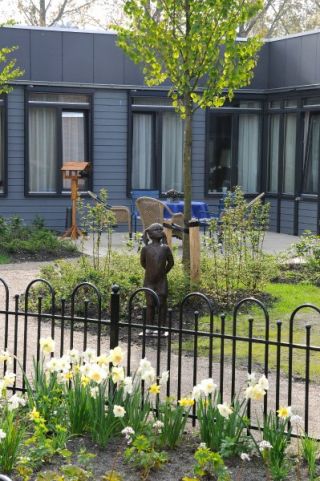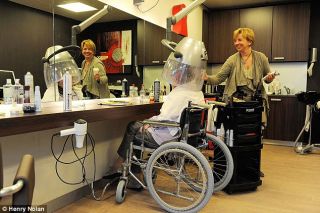Uma vila holandesa projetada para idosos com Alzheimer, em Weesp quw é um município dos Países Baixos e abriga um asilo bastante incomum. Na verdade, o nome asilo não cabe para o lugar que mais se parece com uma vila.
Hogeweyk é o nome da vila projetada especialmente para o cuidado de idosos com demência — especialmente demências degenerativas como o Alzheimer.
por lá estão médicos, efermeiros e especialistas trabalhando para cuidar dos 152 residentes que precisam de menos medicamentos que os do ''lado de fora''.
Essa foi a primeira grande vantagem do lugar que me chamou atenção. Segundo o sitePsychology Today, os residentes da vila são mais ativos que os residentes de asilos convencionais e também demandam menos remédios para controlar suas condições médicas.
Ruas, praças, parques e jardins foram todos desenvolvidos para que os idosos pudessem transitar livremente sem grandes problemas. E é isso que eles fazem.
Os médicos e enfermeiros são instruídos para fazer da experiência dos idosos o mais próximo da realidade possível. Embora as condições de demência possam exigir grandes cuidados, são os próprios moradores que fazem as compras no supermercado e ajudam no preparo da comida em casa.
Apenas os aspectos financeiros são deixados de lado por sua natureza mais complexa — não existe moeda no local e tudo está incluso no pacote que se paga para morar lá.
Os cuidadores vestem roupas normais em vez de roupas clínicas e se encaixam perfeitamente nos papéis de vizinhos e empregados do lar. Eles também não corrigem quando os residentes decidem falar sobre suas memórias, seu passado e história. Todos os funcionários do lugar estão lá apenas para dar apoio a situação delicada dos idosos.
Segundo The Atlantic:
“Os residentes são cuidados por 250 enfermeiros e especialistas em tempo integral e parcial, que vagueiam pela cidade e possuem uma infinidade de profissões na vila, como caixas de supermercado e atendentes.”
Iniciativas como essa nos fazem acreditar no desenvolvimento humano.
HISTÓRIA DA IDEIA
When Yvonne van Amerongen received a phone call from her mother two decades ago, relaying that her father had died of a heart attack—sudden and painless—one of the first things she thought was, Thank God he never had to be in a nursing home.
Van Amerongen was working as a staff member at a traditional Dutch nursing home at the time, getting a front-line view of what she never wanted for her parents. That call from her mother spurred Yvonne into action as she became committed to making nursing homes more livable and less of a departure from reality for their residents. She envisioned a setup as far away as possible from the nondescript buildings and polished floors of her workplace, where everything carried the scent of a dentist’s medical cabinet. Over the next 20 years, she worked to secure the funding she’d need to make the idea a reality.
Today, the isolated village of Hogewey lies on the outskirts of Amsterdam in the small town of Wheesp. Dubbed “Dementia Village” by CNN, Hogewey is a cutting-edge elderly-care facility—roughly the size of 10 football fields—where residents are given the chance to live seemingly normal lives. With only 152 inhabitants, it’s run like a more benevolent version of The Truman Show, if The Truman Show were about dementia and Alzheimer’s patients. Like most small villages, it has its own town square, theater, garden, and post office. Unlike typical villages, however, this one has cameras monitoring residents every hour of every day, caretakers posing in street clothes, and only one door in and out of town, all part of a security system designed to keep the community safe. Friends and family are encouraged to visit. Some come every day. Last year, CNN reported that residents at Hogewey require fewer medications, eat better, live longer, and appear more joyful than those in standard elderly-care facilities.
There are no wards, long hallways, or corridors at the facility. Residents live in groups of six or seven to a house, with one or two caretakers. Perhaps the most unique element of the facility—apart from the stealthy “gardener” caretakers—is its approach toward housing. Hogeway features 23 uniquely stylized homes, furnished around the time period when residents’ short-term memories stopped properly functioning. There are homes resembling the 1950s, 1970s, and 2000s, accurate down to the tablecloths, because it helps residents feel as if they’re home. Residents are cared for by 250 full- and part-time geriatric nurses and specialists, who wander the town and hold a myriad of occupations in the village, like cashiers, grocery-store attendees, and post-office clerks. Finances are often one of the trickier life skills for dementia or Alzheimer’s patients to retain, which is why Hogewey takes it out of the equation; everything is included with the family’s payment plan, and there is no currency exchanged within the confines of the village.
Residents are only admitted if they’re categorized as having “severe cases of dementia or Alzheimer’s disease.” Vacancies are rare, given that a spot only opens when a current resident passes away, and the village has operated virtually at full capacity since it opened in 2009. Hogewey was primarily funded by the Dutch government and cost slightly more than $25 million to build. The cost of care is nearly $8,000 per month, but the Dutch government subsidizes the residents—all of whom receive private rooms—to varying degrees; the amount each family pays is based on income, but never exceeds $3,600.
To put it into perspective, a private room at a U.S. nursing home cost an average of $248 per day in 2012, or more than $90,500 annually—a figure that’s even more staggering when applied to the rapid increase in dementia patients globally. By 2030, the number of people suffering from dementia around the world is expected to hit 76 million, which some estimate will cause an 85 percent increase in dementia-related healthcare costs worldwide. By 2050, the U.S. alone will pay a projected $1.2 trillion.
Often, nursing homes are linked to poor quality of life for their residents: Issues of patient mistreatment and low levels of morale have plagued U.S. assisted-living facilities, and a recent report from the Dutch Alzheimer’s Association found that nursing-home residents in the Netherlands go outside for an average of just 96 seconds per day. By contrast, Hogewey’s staff promotes an active lifestyle for residents.
“The environmental approaches to reducing both cognitive and behavioral problems associated with dementia are really the key to improving quality of life for these patients without excess medication,” Dr. Paul Newhouse, director of Vanderbilt University’s Center for Cognitive Medicine, told ABC News in 2012.
The act of engaging in community isn’t just about promoting better healthcare; it’s about developing a more personable and comprehensive way of treating disease. Often those with the most severe mental-health issues end up being isolated, so that less complicated cases can benefit from institutional resources. However, a study from the journal Nature Neuroscience found that isolation actually reduces the production of myelin—a fiber that maintains our nerve cells—meaning these segregating treatments may only make mental illness worse. The countless studies reinforcing how many dementia patients feel lonely or isolated, juxtaposed with Hogewey’s considerable success with these residents, call into question how much of dementia is a result of disease, and how much is a result of how we treat it.

Via: http://awebic.com/
Stepping Back in Time: Help for Alzheimer's
New state-of-the-art dementia treatment facility is a 1950s era village.
The number one fear of old age is without a doubt receiving the diagnosis of Alzheimer'sdementia. According to Dementia statistics, in 2010 approximately 35.6 million people had dementia; in 2030 it is expected to almost double to 65.7 million. What can be done to ensure that our parents, loved ones and yes, we ourselves, can enjoy life as fully as possible while living out our Golden Years?
Let me introduce to you Hogewey, an amazing "village" on the outskirts of Amsterdam. It's a step back into the 1950s boasting pretty, manicured streets, a grocery, cafe, coffee shop, restaurant and even a beauty salon and barber shop. There are 152 residents in Hogewey, and all have something in common—dementia. You see, Hogewey is not a real village; it is a treatment facility for dementia and Alzheimer's patients.

Hogewey patients walk freely around the village.
Those who are lucky enough to live there, do so in a time gone by, a time when many were in their prime. It is set in the 1950s because the dementia patient's long term memory is preserved much more vividly than short term. Thus they can relate to things from their younger days, which gives a feeling of familiarity, safety and comfort.
Dementia waxes and wanes; with times of clarity interspersed with periods of confusion and memory loss. It's during those moments of clarity that Hogewey becomes priceless. Instead of a nursing home, with cold steel, linoleum floors, the smell of antiseptic and staff members wearing white, they live in a neighborhood. Patients come and go as they please, because the village, which takes up a city block, is staffed by "villagers" who are really trained geriatric nurses and specialists, all there to help the residents when needed. Patients are free to take a buggy and walk to the supermarket, go grab a coffee or get a meal in the cafe. If they forget their wallet, no problem. If they get lost, there's always a "villager" to help them get home, and if they load up with 20 cans of tomato sauce, an aide will return the extras to the grocery later that day.

A patient talks to a nurse working incognito at the Hogewey supermarket.
Hogewey officials say that after a few weeks, residents improve dramatically, require less medication and become calmer. Naturally, they have a very long waiting list, and relatives of the inhabitants praise Hogewey and offer their sincerest gratitude.

A Hogewey resident gets her hair done at the onsite salon.
This is a groundbreaking approach to treating dementia and Alzheimer's. In fact, Germany sent a delegation to study the Dutch village, and has already announced it is planning on building its first village in Bern. One is also being built in Switzerland and hopefully the U.S. won’t be far behind. The cost is comparable to a standard nursing home facility, yet the rewards are priceless.
Locking the elderly in a cold, hospital setting, with specific visiting hours and time for meds and meals scheduled in advance is, thankfully, going to be a thing of the past. The elderly deserve nothing less than our respect and compassion, and this type of setting will ensure they experience their last years in a ‘normal,’ happy setting.
We all hope that our loved ones will never have to be removed from their home and independence for their own protection due to the ravages of dementia. But if they do, I certainly hope this is an option for all of us to consider.
Via:www.psychologytoday.com

Nenhum comentário:
Postar um comentário
Deposite aqui sua idéia